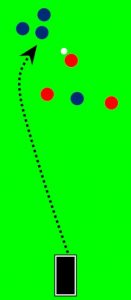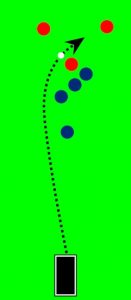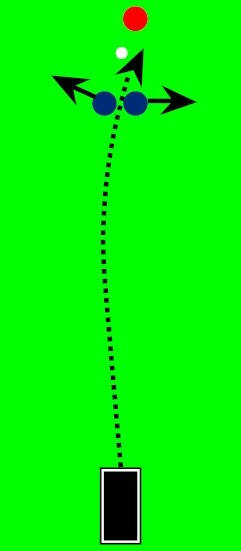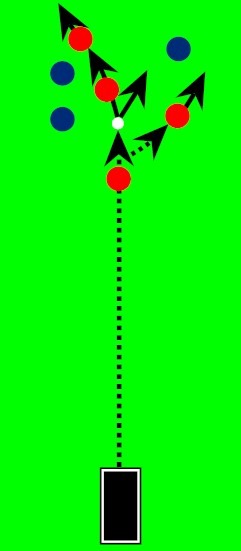BOWLS SHOTS
Lead and the Draw shots
If you start off by playing the lead in a team you have plenty of opportunity to practice the Draw shot, and there can be no better experience. First thing a lead has to do is select the truer side of the rink, and one is usually truer than the other (outdoors). Once that choice has been made you should stick to it bowling forehand one way and backhand the other. Occasionally a rink will be playing truer down one side and up the other in which case you will want to stick to the appropriate hand, but that is very much the exception to the rule.
The tendency for preference for one hand over the other must be strongly resisted. Assuming sound technique the deliveries are identical leg body and arm moving directly down the line of delivery, the only difference is grounding the bowl about a foot outside the mat (forehand) and near the backhand corner of the mat (backhand). You should find no greater difficulty in grounding the bowl in one spot and the other. But, if you do initially feel less confident on a particular hand, strive to overcome that feeling.
The Draw shot
The draw shot is by far the most important of bowls shots in the game justifying its description as the ‘bread and butter shot’. If you fail to come to terms with this shot you will never be a competent bowler. Only by mastering it will you become a really good one. The object of the game of bowls is to get your bowl as close to the jack as possible and for the most part that means drawing to the jack.
The draw shot however, means much more than drawing to the jack. Even if that is its most common application. Any positional shot is a draw whether short or long, on the line of the jack or elsewhere on the green along another line. Then consider all these shots into the head where you are trying to move an opponents bowl, promote your own, trail the jack and so on. In each of these cases you take more green or less, add weight or take it off. In every case that modification, more or less is in relation to the draw. The most elementary draw shot is the one to an open jack.
Whilst drawing to a fixed jack is the norm during the early stages of an end, as the head builds up the jack is likely to be moved from its spot, often a considerable distance away. Drawing to a displaced jack necessitates an adjustment to line or length, usually both. Assuming you have a good command of both, that should not be too difficult. However, the realities of outdoor bowling add a slight complication. The grass immediately around the centre line, jack high is where most of the action takes place and tends to get flattened by both bowls and feet. If the jack gets moved out to fresh grass the bowl will encounter increased resistance as it gets to it. This requires you to tighten your line a little and increase the strength.
Positional

This term refers to any draw shot that is not directed at the jack. That is, to a particular position on the green, invariably for tactical considerations. There are any number of reasons for playing a positional shot which need not be described in detail here. From a technical standpoint it is exactly the same as drawing to the jack, with the desired position substituted for the jack, and line and length adjusted accordingly. Two positional draws are very common, and merit their own name. The ‘rest shot’ and ‘the blocker’
The ‘rest shot’ is a delicate variation of the ‘draw’ employed when the jack is less accessible than the opponents shot bowl. The shot bowl becomes the substitute jack, the aim being to come right up and ‘rest’ against it on the inside i.e. nearer the jack.
Blocker

A blocker can be an invaluable weapon, and will often transform an end. It is a short bowl intended to impede the opponents approach into the head and is commonly used when the head is in your favour, but is vulnerable to counter attack. It is positioned close to the head where it will be most effective against the draw, and well short of the head to counter the effect of a drive. A poorly executed blocker is, of course, a wasted bowl.
Trailing the Jack

This involves bowling to the jack with enough added weight to pick the jack up and trail it to some other location, either further back in the head or all the way to the ditch. The trail is generally reckoned the most difficult shot in the game, because the jack is such a small target in comparison to a bowl. Not only is such pinpoint accuracy extremely difficult, even for the most accomplished bowlers, but a near-miss can be infinitely worse than a bowl much wide of the mark.
Tap and lie shot

If you accept the convention of the ‘yard-on’ as a weighted bowl with anything between a yard and 2 yards running, the ‘tap and lie, is a light ‘yard-on’ with about 2 feet of running. The aim of the shot is to tap the object bowl out of the way, delicately enough to lie in the position vacated. Its alternative name is the wrest shot’ because the object is to “wrest” possession of the object bowl’s position.
Instead of picking-up the jack cleanly, it is dealt a glancing blow and slice it straight towards a waiting opposition bowl, the very last result desired. This shot, therefore, must be approached with much circumspection. It may often be an option, but it is rarely the ‘best’ option. The ‘trail’ is usually reserved for the later stages of an end and in particular as a last shot, when your opponent is holding shot but you have bowls clustered behind. A draw with your final bowl may give you the ‘end’ but a ‘trail’ would give you a successful ‘count’.
Wick-and-Plant

The wick is a ricochet shot, when the bowl comes into the head, cannons off another bowl and (maybe) approaches the jack by this circuitous route. It is exactly the same as a ‘cannon’ in snooker parlance, but like the ‘cannon’ is likely to raise eyebrows if it produces a favourable result. No matter if the jack cannot be approached directly and if there is a realistic chance of wicking onto it, then you should certainly consider this option. The most favourable circumstances is where two or more bowls are tight together in the head, sitting in such a way that a ricochet in the right direction is the likely outcome of getting in amongst them. The wick is best suited to a medium paced green.
Before attempting a wick, weigh the odds. It is unlikely that you would be tempted by it if the head were in your favour. However even if the head is against you what you must consider in such a chancy shot is the consequences of failure. If you see a distinct possibility that a botched attempt would disturb the head in such a way as to worsen your plight then look for a less risky way of extricating yourself
If two bowls are actually touching, striking one will propel the other in a predictable direction. Wherever you make contact with the first bowl the second will take off straight along the line in which it was placed in relation to the first. As a bowler you should take a leaf from a snooker players book and be looking for ‘plants’ all the time, but it must be considered very carefully. It can be ideal for promoting your own bowl, or for getting rid of an opponents. Remember that if the two bowls are not actually touching, the plant looses its predictability.
The thing to remember with these shots and other shots into a mature head, is that they can be viewed as second choices. They are basically ‘yard-on’ shots and when you look at the head, and work out what to play, consider the consequences of a near-miss.
Running Shot's
Strictly speaking any shot played with greater than ‘draw’ weight is a ‘running shot’, although at the gentler end of the spectrum, the ‘running shots’ have almost everything in common with the ‘draw’ itself and little in common with the full blooded ‘drive’ or firing shot’. As you would expect, the shots in the
middle of the spectrum combine features of both. For clarity’s sake it is desirable to group the various running shots under three headings (a) the ‘yard-on shot’ and all its close relations that require just a little added weight (b) ‘firm woods’ which require stepping up a gear, (c) ‘driving shots’ which may vary in weight but are unmistakably aggressive in intent.
Between these comparatively delicate running shots, and the ‘drive’ there lies a huge range of possible weights. Firm woods sometimes called ‘timing shots’ are all those shots played with substantial but controlled weight. The aim is to take out an opponents bowl, promote your own or shake up a head that is unfavourable. Whether it is a shot with several yards of weight. A semi-drive, trailing the jack to the ditch, the principle of delivery is the same. The key point is that the weight is controlled, and there is some allowance for bias.
The Yard on Shot

This can be a confusing term because of its implied precision. A shot made with a yard more than draw weight. In fact a good case can be made for striking the term from the bowling vocabulary for precisely this reason. It is common to see a skip indicate an opposition bowl which he wants removed. Request a yard-on shot. When in reality, to achieve the result, the shot must be played with say ‘2 yards’ of extra weight. When the skip says ‘yard-on’ to his player. He really means sufficient weight to shift the offending bowl out of the way. That is a very imprecise way of giving instructions.
The ‘yard-on’ is usually employed as a rescue shot. When the head is against you but still salvageable. It may be the preferred option. Even when there is a clear route to the jack, if you hold second wood, and need only remove the shot bowl and stay near to make a substantial count. To execute any running shot. You must allow for the fact that an increase in pace cuts down the effect of bias. So they are always straighter than the draw, more or less. For the ‘yard-on’ it is only a little straighter on heavy greens, on very fast greens, even a yard of extra weight requires significant adjustment to line.
Firm Woods

One of the most effective shots, is the ‘run-through’ where the head is closed with short bowls barring your way through to the jack. If you can come into those short bowls with several yards of running. You should scatter them and find your own bowl running through by a yard or so which can transform the head in your favour. This can be spectacular. Where there are two blocking bowls, side by side, not touching but with insufficient space to pass between them. If you can hit the gap on the inside of either bowl. You will split them and run sweetly through in a straight line
Firm woods are much favoured in Britain. Because the line is tighter and the weight more easily gauged on heavy greens. The final consideration. Wherever possible, when you are trying to take a bowl out of the head. Attack it from the ‘hand’ that swings away from the head rather than toward the head. As you are swinging across the head and out. An imperfect contact should propel the bowl away from the head. The alternative coming into the head could have regrettable consequences.
The Drive

The most spectacular shot in the bowler’s armoury is also the most controversial. As little as a generation ago, the ‘drive’ was rather frowned upon in Britain. Even unsporting. In clubs today you can still encounter some distaste for the drive. Certainly if it is employed routinely, rather than in exceptional circumstances. It must be admitted that an over reliance in the drive does not make for attractive bowls. Even the best exponents of the drive will admit that they win more by drawing than driving. If you play ‘touch’ shots well enough, you should not have to fall back on the drive very often. Nevertheless, there are situations where the drive is the best available option.
The drive is essentially a rescue shot. Often your last line of defence. When the head is set against you. There is nothing you can realistically hope to achieve by playing any other shot. If you are several shots down and there is no way you can significantly lower the count against you. There are several favourable outcomes that could come from a drive. Best of all you might be able to displace your opponents counters. Spring the jack for a trail, taking shot or even ending up with a count yourself.
More realistically you might ditch the jack and follow it in. Take the jack out of the confines of the rink and kill the end. An excellent result when you are facing a count. Because of the unpredictability of the outcome. It is important not to rush into the drive without weighing up all the alternatives. It is generally not a good idea to drive if you are only a single shot down. Even if you have a couple of second woods, you might hit them instead and go down by a handful. Another instance where the drive is effective is when your opponent has shots around the jack but not in front. In which case if you attempt to drive the jack into the ditch and miss. You may well clear out one or more bowls. The drive is aimed straight at the target. So must be delivered with sufficient pace to nullify the effect of the bias.
